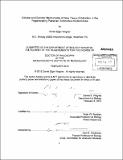Cellular and genetic mechanisms of new tissue production in the regenerating planarian Schmidtea mediterranea
Author(s)
Wagner, Daniel Elger
DownloadFull printable version (18.44Mb)
Other Contributors
Massachusetts Institute of Technology. Dept. of Biology.
Advisor
Peter W. Reddien.
Terms of use
Metadata
Show full item recordAbstract
Regeneration of missing body parts is biologically fascinating, yet poorly understood. Many instances of regeneration, such as the replacement of amphibian limbs or planarian heads, require both a source for new cellular material as well as mechanisms to specify, differentiate, and pattern the regenerate. The planarian Schmidtea mediterranea is a classic system for studies of regenerative biology in which proliferating cells known as "neoblasts" provide the source of new cellular material for regeneration. Stem cells that might be present within the neoblast population, however, have not yet been defined. Such cells could therefore be either pluripotent or, alternatively, a heterogeneous collection of lineage-restricted cell types. In order to distinguish these models experimentally, methods for clonal analysis were developed here and used to assess descendants of individual neoblasts. Individual cells, termed "Clonogenic Neoblasts" (cNeoblasts) were identified that gave rise to large descendant cell colonies in vivo. Individual cNeoblasts generate descendants spanning multiple germ layers and, in single cell transplantation experiments, all cells of the adult body. These data indicate that adult pluripotent stem cells (cNeoblasts) are the source of new tissue for planarian regeneration. Despite a sequenced genome and the availability of RNAi, the genetic basis for stem cell regulation in Schmidtea mediterranea has remained largely unexplored. Using microarrays, a genome-scale approach was taken to identify and characterize genetic factors specifically expressed in proliferating cells (neoblasts) of adult planarians. Genes identified by microarray were RNAi screened using quantitative assays (developed here) for expansion and differentiation of cNeoblast descendants. Several genes encoding proteins with conserved roles in germ cell biology (e.g. Vasa) and chromatin regulation (e.g. Polycomb proteins Ezh, Sz12, and Eed) were identified as required for proliferative cell expansion and/or differentiation, along with additional genes encoding three zinc finger proteins, two transcription factors, and two candidate RNA-binding proteins. These experiments suggest that cNeoblast regulation involves mechanisms shared with germ cells and embryonic stem cells, and provide a powerful framework for future investigations of planarian stem cell function.
Description
Thesis (Ph. D.)--Massachusetts Institute of Technology, Dept. of Biology, 2012. Cataloged from PDF version of thesis. Includes bibliographical references.
Date issued
2012Department
Massachusetts Institute of Technology. Department of BiologyPublisher
Massachusetts Institute of Technology
Keywords
Biology.